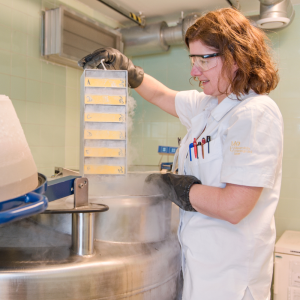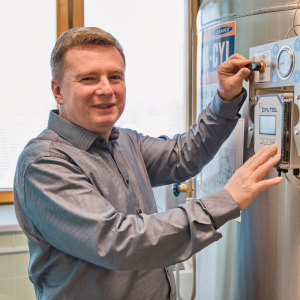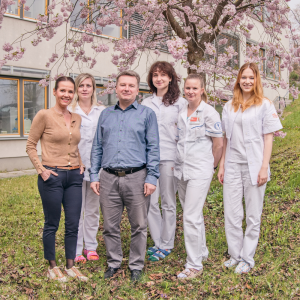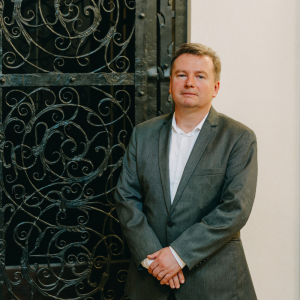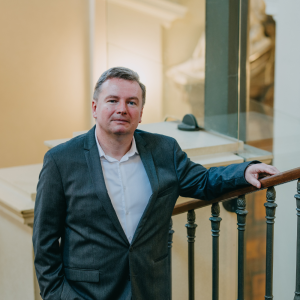
Again and better! That is the motto of Roman Hrstka’s research group, which is part of NICR and based at the Masaryk Memorial Cancer Institute. It focuses on the identification, evaluation, and transfer into clinical practice of specific cancer biomarkers, which can then be used as therapeutic targets, improve diagnostics, help monitor minimal residual disease, detect the presence of metastases, or anticipate the risk of their emergence. And because research would not be possible without human tissue samples, Roman Hrstka is also actively involved with the organisation, development, and cultivation of biobanking both in the Czech Republic and Europe as a whole.
-
Specific cancer biomarkers, that is the holy grail sought by many research groups: are you following in some ways a different route than the mainstream?
You are quite right. Many research groups both in the Czech Republic and abroad focus on biomarkers. Nevertheless, in order for research to make sense and be financially sustainable, it must be original and have added value at least for the scientific community by its contribution to knowledge. Optimally, it should benefit the society as a whole.
So, to answer your question: in essence all research should go, at least at first glance, a little against the mainstream to bring something new. I hope our research meets these parameters. As an example, I would mention the AGR2 (anterior gradient 2) protein, which belongs in the family of protein disulphide isomerases. I have been investigating this marker for almost 15 years. Changes in its expression are associated with inflammatory diseases of the gastrointestinal tract and with the development various carcinomas, for instance of the mammary glands, pancreas, intestines, the lungs, ovaries, prostate, and liver, and with the development of their metastases. AGR2 is thus a good candidate for a diagnostic cancer marker. Initially, I had some results that ran quite contrary to what colleagues in France had found but then it turned out that it was because they investigated the role of extracellular protein, while I focused on the function of intracellular protein in cancer cells…
-
In your work, do you use regularly available modern technologies, or do you also develop also your own? And why?
In the Research Centre for Applied Molecular Oncology, RECAMO, we have at our disposal state-of-the-art equipment and technologies that can be used in cancer research. Even so, what we need for our research is often highly specific and available technologies are in many ways not quite optimally suited. That is why in our institute we also work on developing new methods, reporter systems, biosensors, and the like, which should be sufficiently sensitive and form ideally also a cheaper and faster alternative to the currently existing solutions.
-
The development of new detection methods and equipment, in particular biosensors, requires a multidisciplinary effort. What specialisations, fields, and institutions do you collaborate with the most, both within the NICR and outside it?
Multidisciplinary cooperation is in this area a necessity. In our institute, it takes mainly the form of cooperation with various clinical departments within the Masaryk Memorial Cancer Institute, for instance with the Department of Comprehensive Cancer Care or Department of Urologic Oncology. Outside the Institute, it is for me especially the Clinic of Gynaecology and Obstetrics of the Faculty of Medicine of Masaryk University and the University Hospital Brno.
I should also mention that not all collaboration takes the form of provision of clinical material and medical data. We also successfully work together on study design, technology transfer, selection of suitable biomarkers, or specific analyses not accessible at our workplace. In this respect, we were greatly helped by our involvement in NICR, which aims at creating a nation-wide network of collaborating teams that conduct cutting-edge oncology research. I would especially like to mention cooperation with Professor Hocek (Institute of Organic Chemistry and Biochemistry, CAS), whose team has been assisting us with organic synthesis of labelled nucleotides, or cooperation with doc. Bouchal (Faculty of Science, Masaryk University), where we focus on identifying new biomarkers using proteogenomic analyses.
We also work with and draw on the experience of foreign institutions, for instance in the area of nanotechnologies (Prof. Gómez Ruiz, Universidad Rey Juan Carlos, Madrid), material chemistry and bioengineering (Dr. Melnik, Austrian Institute of Technology, Vienna), or in the development of some electrochemical biosensors (Prof. Campuzano, Universidad Complutense de Madrid, Madrid).
-
Your research also deals with the testing of organometallic compounds as potential diagnostic probes and anti-tumour treatments. How do they work and where do you see their potential?
That research is based on our long-term cooperation with Dr. Karban from the Institute of Chemical Processes of the CAS and Dr. Pinkas from the Institute of Physical Chemistry of J. Heyrovský of the CAS. Organometallic compounds combine organic ligands with a central metallic atom, which enables specific interactions with various biomolecules. Thanks to this, they can function not only as effective cancer drugs but also as highly selective diagnostic probes. Their potential is based especially on the fact that one can quite flexibly adjust their structure, for instance by changing the type of metal or the ligand. Such modifications then selectively modify their biological activity, stability, or ability to selectively affect cancer cells. All in all, I thus believe that organometallic compounds have a great potential: in the future, they could help expand the possibilities of targeted diagnostics and therapy and not only with respect to cancers.
-
The study of new biomarkers requires testing that uses human biological samples. That brings us to the fact that you also work as the executive director of the Bank of Biological Material of the Masaryk Memorial Cancer Institute (MMCI) and as the national coordinator of the BBMRI.cz (Biobanking and Biomolecular Resources Research Infrastructure of the Czech Republic). What has been the role of the MMCI Institute in its creation and existence?
The Bank of biological material at MMCI is one of the oldest Czech biobanks: it has been functioning since 2000. Its director at that time, Dr. Nenutil, then initiated the creation of a national hub of the BBMRI within a Europe-wide project from ESFRI Roadmap, which in turn led to the formation of a network of biobanks. At that time, it was called BBMRI_CZ and consisted of four hubs at four large university hospitals (in Pilsen, Prague, Hradec Králové, and Olomouc) and a national coordinator, which was the MMCI. Currently, this distributed large research infrastructure consists of eight participating biobanks managed by six institutions.
-
The term ‘banking’ can be translated into Czech in the sense of both a system and a process. Which of these two senses do you prefer in the context of biobanking?
I personally prefer the English term ‘biobanking’, but it seems that a Czech equivalent is nowadays also used quite often. Unfortunately, I believe that many Czechs still have not heard about biobanks or biobanking regardless of the form of the term.
-
How does the scientific community fare in terms of awareness of the services you offer and their use?
At a certain point or in some areas of research, it is simply not sufficient to rely just on testing cell lines (in vitro) or animal models (in vivo), because these models cannot sufficiently well simulate the complexity of human tissues. In such situations, one needs to use real biological material; that can be the case of research of diagnostic methods, characterisation of the origins of the disease, development of a new drug, or identification of new biomarkers.
Although all of the abovementioned areas interface with numerous disciplines, I must say that awareness of services offered by the BBMRI.cz could improve. That is also why we have in our team colleagues who, among other things, focus on communication with potential users; any opportunity to make biobanks more visible for scientists, patients, and the general public is always very welcome.
-
Kindly remind us: how does biobanking actually work?
Biobanking is the process of collecting, processing, and long-term archiving of biological material under standardised and monitored conditions in a biobank. This process is always preceded by consent of the donor, who agrees to a further use of left-over biological material that was collected for diagnostic purposes and is no longer needed or, alternatively, consents to his or her biological material being collected for scientific purposes and kept in a biobank. Such material is then made available to applicants based on the provision of various requisite documentation and subsequent agreement by the ethics board and the consulting body of the biobank in question. I should also add that donors have the right to revoke their agreement at any point and, in such case, the relevant samples are destroyed.
-
Is it difficult to obtain from patients their informed consent with preserving their biological material in a biobank? What reactions are you meeting with and does the general public have any preconceptions or worries associated with donation? How is this issue addressed by Czech and European legislation?
Several years ago, a survey was conducted in four countries of the EU: people were asked whether they would be willing to provide material from their own body for research purposes. About 80% of respondents answered in the affirmative. In the Masaryk Memorial Cancer Institute, a vast majority of donors give their consent freely and without any reservations. They want to support research so that patients who currently struggle with a disease or future patients could benefit from new methods, drugs, or findings. I am aware of a lot of apprehension among people, but most people also realise that without research and development there would be no new treatments or diagnostic methods. Legislation moreover enables a revocation of consent by the donor at any point, which leads to destruction of the donor’s biological material.
In some European countries, for instance in Sweden and Great Britain, there exists specific legislation on biobanking. In the Czech Republic, we do not have any such specific law: biobanks thus follow general legislation such as the act on medical services, GDPR, and other relevant legal norms.
-
What are the principles expressed by the acronym FAIR that biobanking stands on and how important is standardisation and adherence to it?
The FAIR principles and their implementation are an integral part of a correctly functioning biobank. In particular, it is of the uttermost importance that information about what a given biobank offers, what it means, and what it stores is Findable by potential users. At the same time, the biobank’s services should be Accessible, be it in terms of the biological material or related data and other services. Emphasis is also placed in Interoperability, meaning that if an applicant asks for samples or data from different biobanks, it should be guaranteed that the provided biological material is of a comparable quality and data compatible with other formats so they can be integrated with other datasets (Interoperable). And finally, a biobank must provide Reusability, that is, both data and samples must be sufficiently well described and documented to allow for their reuse by others.
-
In the traditional sense of the word, banking is based on some quid pro quo. What does a biobank acquire from researchers in return for the samples it provides? Is it, for instance, a ‘deposit’ in the form of results and data, which other researchers could use in the future?
Every biobank, both here and abroad, has its negotiation processes and conditions under which it provides the material or data to applicants. Depending on these conditions, the biobank and the applicant sign an agreement, so-called MTA/DTA (Material/Data Transfer Agreement), which summarises the obligations of the applicant and the biobank. For instance, in our biobank we provide biological material and basic data to the academic sphere for free. The only thing we ask for is that the biobank, eventually BBMRI.cz – Network of Czech Biobanks, be listed as the source of biological material in relevant publications and in case of co-authorship, the infrastructure should be named under its current code.
Another aspect of this issue is the currently much debated reuse of data generated based on the provision of a given sample (open science principles). Imagine, for instance, a situation where a researcher conducts sequence analysis on a sample provided by a biobank. This is an expensive method that would not need to be done repeatedly if data sharing was introduced and the biobank received the sequencing data, so it could offer them to further users. This is related to the fact that each sample is collected in a larger number of homogeneous specimens, so-called aliquots. One can thus request and loan a given sample a number of times. So, far, this concept of data sharing is not commonplace in the Czech Republic, but it seems to be a direction we are going to take.
-
BBMRI.cz is part of the BBMRI-ERIC European consortium. What does involvement in an international infrastructure bring to the Czech Republic?
BBMRI.cz is not only part of the European consortium BBMRI-ERIC but also its founding member in 2013. There are several notable advantages to membership in this consortium. First of all, we can directly participate in creating supranational policies related to biobanking, including ethical and legal ones. Secondly, involvement in BBMRI-ERIC helps Czech scientists and institutions to establish effective cooperation with research teams from other European countries, which in turn leads to knowledge transfer, sharing of experience, and creation of joint research projects. All this contributes to a strengthening of the scientific potential of the Czech Republic at an international level. Another contribution is that a direct link to BBMRI-ERIC provides Czech biobanks and their host institutions access to European calls for financing of international research projects. And last but not least, thanks to access to large biobanks and data, Czech institutions can contribute to the development of personalised medicine, which includes research focused on the identification of genetic and biomolecular markers that can aid the diagnostics and treatment of various diseases.
-
In 2024, BBMRI-ERIC has introduced its 10-year plan based on the One Health principle, that is, linking human, animal, and environmental health. How ambitious are the goals that face biobanks?
In recent years, emphasis has been especially on human diseases and ways of influencing their progression. The One Health concept stresses the need for understanding the influence of other factors and their role in the emergence of diseases, including veterinary research and ecological changes.
In order to implement the One Health concept, we need to agree on a unified framework of sharing of biological material and data (clinical and research data as well as metadata) among European countries, institutions, and biobanks. This is closely related to standardisation and monitoring of quality of samples as well as data among different types of biobanks (environmental, animal, and human ones), which is one of the many tasks within a 10-year plan of BBMRI-ERIC. Integration of modern omic technologies (transcriptomics, genomics, metabolomics, etc.) or bioinformatics in biobanks should help us connect interdisciplinary data and identify risk factors for the emergence of new diseases across scientific fields.
There are many challenges we are going to face in the next ten years, but one cannot just stand in one place and be unprepared. The comprehensive One Health approach will help us uncover many connections which will, in turn, help make both prevention and diagnostics of various diseases more effective, and that not only on a local but also a global scale.
- By the way, when one says ‘banker’, one could imagine the cliché of a well-off man in a suit, with a vest, top hat, a monocle, and a cigar between his teeth. What attributes would characterise you as ‘biobankers’?
I would say biobankers are rather busy people in white lab coats who run between an office with a computer where they input data, a lab where they process samples, and facilities where biological material is stored.


